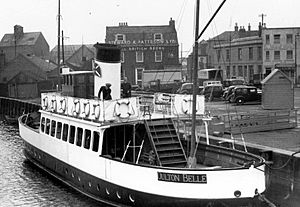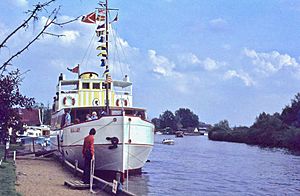MV Regal Lady facts for kids
{{multiple issues|1=<nowiki>

MV Regal Lady at Great Yarmouth Town Hall Quay
|
|
Quick facts for kids History |
|
|---|---|
| Name | Regal Lady (Oulton Belle until 1954) |
| Owner | Heath Samples |
| Builder | Fellows & Co, Great Yarmouth |
| Launched | 23 May 1930 |
| Out of service | 2020 |
| Status | Museum |
| General characteristics | |
| Class and type | V |
| Tonnage | 72 GRT |
| Length | 84tt |
| Beam | 16ft 6inches |
| Height | (Not including mast tips) 25ft |
| Draught | 6ft 6inches (fresh water)Error: has synonymous parameter (help) |
| Draft | 6ft 6inchesError: has synonymous parameter (help) |
| Depth | 2.01 |
| Decks | 3 |
| Installed power | (1954 to 1984 Norwich Verified 160 HP Glenniffer DC8 Clutch cone reversing gear box and 3/1 reduction box |
| Propulsion | Motor |
| Speed | 9 Knots |
| Capacity | (Oulton Belle 300) (Regal Lady Norwich 1971 to 1984 222) |
| Crew | (Norwich 1971 to 1984) - Total 5 |
The MV Regal Lady is a special passenger boat built in 1930. She is made of steel and is now docked in Scarborough, North Yorkshire. This boat is considered a National Historic Ship. She is looked after by Scarborough Pleasure Steamers. The Regal Lady was part of a very important event called Operation Dynamo during World War II. She helped rescue soldiers from Dunkirk. After the war, she stopped being used for military purposes in 1946. In 1954, she moved to Scarborough and got her new name, Regal Lady. Before that, she was called Oulton Belle.
Contents
How the Regal Lady Works
The Regal Lady is powered by a Gardner Marine diesel engine. This engine helps her cruise at a speed of nine knots. A knot is a way to measure speed for boats.
What makes her special is her steering system. She has two rudders, which are like fins that help steer the boat. One rudder is at the front and one is at the back. When she goes backward, the front rudder helps her steer. When she goes forward, the back rudder does the steering. Her steering system uses chains and wires connected to a large ship's wheel. This is an original part of the boat.
In 1948, some changes were made to the boat. Her front propeller was removed. The old funnel, which is like a chimney, was replaced. An upper deck was also added for passengers. In 1954, her old steam engine was taken out. It was replaced with a powerful 160 horsepower diesel engine. This new engine allowed her to cruise at about 10 knots.
The History of the Regal Lady
The Regal Lady was first launched on May 23, 1930. This happened at Fellows and Co in Great Yarmouth. Lady Fellow officially launched the boat. She was built with a special design that was good for the Oulton Broad area. This design made her look the same at both the front and the back. She was called a 'double-ender'.
Originally, the Regal Lady had two propellers under the water. One was at the front and one at the back. This was because she was too big to turn around easily in the narrow Norfolk waterways. Her first engine was a steam engine.
In 1940, the Regal Lady and her crew were asked to help the Navy. They took part in Operation Dynamo. This was a huge rescue mission during World War II. It is known that the Regal Lady made three trips across the English Channel. She carried 1200 soldiers back to Ramsgate.
After the Dunkirk rescue, the Regal Lady moved to the River Clyde in Scotland. She continued to help in the war. She worked as a tender, which means she helped transport American troops to bigger ships. These big ships included the famous Queen Mary and Queen Elizabeth. In 1945, after the war, she was returned to her original owners.
Passenger Journeys and New Life
The name Regal Lady was given to the boat in 1954. This was when she first moved to Scarborough. It's a tradition in Scarborough for boats to have 'Lady' in their name. The Regal Lady is the sixth and last boat in Scarborough to carry this name.
In 1962, the Regal Lady got radar equipment. Passengers could even look through it for a small fee!
She returned to Norwich in 1970. From 1970 to 1984, she offered cruises from near Foundry Bridge. On January 8, 1987, Tom Machin brought her back to Scarborough. Her wheelhouse, where the captain steers, was replaced with a new one made of glass fibre. Her steel upper structure was also made bigger. She made her first public trip in Scarborough on May 24, 1987.
In February 2020, the Regal Lady was turned into a museum about Dunkirk. She is now docked at Vincent Pier.



